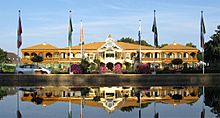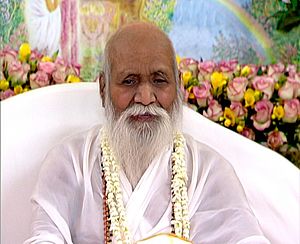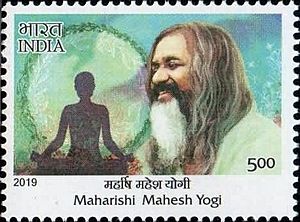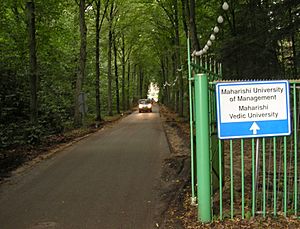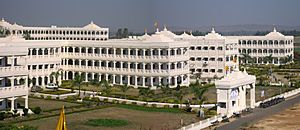Maharishi Mahesh Yogi facts for kids
Quick facts for kids Maharishi Mahesh Yogi |
|
|---|---|
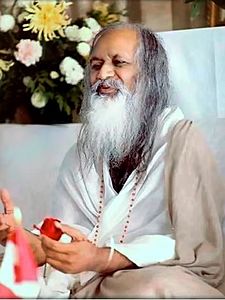
Maharishi Mahesh Yogi in 1978
|
|
| Birth Date | 12 January 1918 Jabalpur, Bhopal, |
| Died on | 5 February 2008 (aged 90) Vlodrop, Limburg, Netherlands |
| Birth name | Mahesh Prasad Varma/Srivastava |
| Guru/teacher | Brahmananda Saraswati |
| Philosophy | Transcendental Meditation |
Maharishi Mahesh Yogi (born Mahesh Prasad Varma, 12 January 1918 – 5 February 2008) was an Indian yoga teacher. He became famous for creating and sharing Transcendental Meditation (TM). He led a worldwide group that taught this meditation. People knew him as Maharishi (meaning "great seer") and Yogi.
After studying physics at Allahabad University in 1942, Maharishi Mahesh Yogi became a student of Swami Brahmananda Saraswati. This spiritual leader was also known as Guru Dev. The Maharishi said Guru Dev inspired his teachings. In 1955, the Maharishi started teaching his meditation, first called Transcendental Deep Meditation. He later renamed it Transcendental Meditation. His first trip around the world began in 1958. His followers called him His Holiness.
The Maharishi trained over 40,000 TM teachers. He taught the Transcendental Meditation technique to more than five million people. He also started thousands of teaching centers and many colleges and schools. His work included schools and universities in countries like India, Canada, the United States, and Switzerland. The Maharishi and his team also created charities and businesses. These included health clinics and organic farms.
In the late 1960s, the Maharishi became very well known. This was because he became the spiritual guide for famous groups like the Beatles and the Beach Boys. In the late 1970s, he started the TM-Sidhi programme. This program aimed to improve the mind and body connection through techniques like Yogic flying. In 1992, he founded the Natural Law Party. He moved to the Netherlands that same year. In 2000, he created the Global Country of World Peace, a non-profit group. He retired from his work in 2008 and passed away three weeks later.
Contents
Maharishi's Early Life
His Birth and Family
Maharishi Mahesh Yogi belonged to the Kayastha caste in India. This caste traditionally included scribes and administrators. His exact birth name and date are not fully known. This is partly because monks often give up their family ties. Many stories say he was born Mahesh Prasad Varma in British India. Other records show his name as M.C. Srivastava.
His birth year is often given as 1911, 1917, or 1918. Some authors say he was born on January 12, 1917, in Jabalpur, India. His passport listed his birth date as January 12, 1918. He likely came from a high-status family.
His Education and Teacher
Mahesh studied physics at Allahabad University and finished his degree in 1942. Most reports say that in 1941, he became a secretary to Swami Brahmananda Saraswati. This spiritual leader was also known as Guru Dev. Mahesh took on a new name, Bal Brahmachari Mahesh. This name showed he was a dedicated student of spiritual knowledge.
Brahmananda Saraswati asked Mahesh to finish his university degree first. The Maharishi remembered how it took him about two and a half years to truly understand Guru Dev's way of thinking. At first, Brahmachari Mahesh did simple tasks. But he soon gained trust and became Guru Dev's personal secretary. He was even allowed to handle Guru Dev's letters without much guidance. He also gave public speeches about Vedic (scriptural) topics. The Maharishi said his true life began in 1940. This was when he learned the secret of deep meditation from his master.
Brahmachari Mahesh stayed with Swami Brahmananda Saraswati until Guru Dev passed away in 1953. After that, he lived a quiet life in the Himalayas for two years. Even though he was a close student, Brahmachari Mahesh could not become Guru Dev's spiritual successor. This was because he was not from the Brahmin caste. Before he died, Guru Dev asked Mahesh to travel and teach meditation to many people.
Sharing Meditation with the World
Teaching in India (1955–1957)
In 1955, Brahmachari Mahesh left the Himalayas. He began teaching a meditation technique that he said came from his master. He called it Transcendental Deep Meditation. Later, it became known as Transcendental Meditation. Around this time, people started calling him "Maharishi." This is an honored title meaning "great sage."
He traveled across India for two years. He spoke to Hindu audiences in an Indian setting. At first, he called his work the Spiritual Development Movement. In 1957, he renamed it the Spiritual Regeneration Movement. When visiting southern India, the Maharishi spoke English. This helped him connect with educated people and avoid language issues.
First World Tours (1958–1968)
In 1958, the Maharishi went to Madras to speak to a large crowd. There, he announced his plan to share TM with the whole world. Many people immediately wanted to learn. In 1959, Maharishi Mahesh Yogi started his first world tour. He said, "I had one thing in mind, that I know something which is useful to every man."
His book, Thirty Years Around the World, tells about his journeys. His first tour started in Myanmar and included Thailand, Singapore, and Hawaii. In Hawaii, a newspaper reported that he had no money and asked for nothing. It said he carried a message to end unhappiness. In 1959, the Maharishi taught TM in Honolulu, San Francisco, New York, and London. He also attracted some famous people.
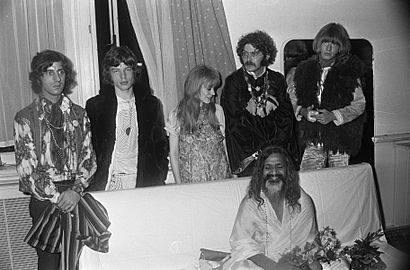
When the Maharishi came to the U.S. in 1959, his movement was called Transcendental Meditation. He started the International Meditation Society to spread his teachings. Centers were set up in San Francisco and London. For years, only one woman, Beulah Smith, taught TM in America.
In 1960, the Maharishi traveled to many cities in Europe, Asia, and Africa. In England, he appeared on TV and in newspapers. He also trained Henry Nyburg, the first TM teacher in Europe.
In 1961, the Maharishi visited the United States, Europe, and Canada. He appeared on BBC television in England. He also gave a lecture to 5,000 people at the Royal Albert Hall in London. In April 1961, he held his first TM Teacher Training Course in India. Sixty people from different countries attended. During this course, the Maharishi began sharing more knowledge. He also started writing his translation of the ancient Vedic text, the Bhagavad Gita.
His 1962 world tour included Europe, Australia, and New Zealand. In Britain, he started a branch of the Spiritual Regeneration Movement. The year ended in California, where he began writing his book The Science of Being and Art of Living.
In 1963, the Maharishi toured Europe, Asia, and North America. He also spoke to members of the Indian Parliament. Twenty-one members supported his goals and meditation technique. His Canadian tour also received good press coverage.
The Maharishi's fifth world tour in 1964 included many cities. In England, he appeared on a BBC TV show. In California, he began teaching advanced TM techniques to experienced meditators. While in America, he met with important leaders like U Thant, the Secretary General of the United Nations. That same year, he finished his book The Science of Being and Art of Living. It sold over a million copies and was printed in fifteen languages.
In 1966, the Maharishi held a course in India. He also toured South America for a month. He opened TM centers in many cities there.
Also in 1966, the Maharishi founded the Students' International Meditation Society ("SIMS"). This group became very successful. In the 1970s, SIMS centers were set up at over a thousand universities.
In 1967, the Maharishi gave a lecture in London. He also lectured at major universities like UCLA and Harvard. That year, Time magazine reported that other Indian sages criticized him. They felt his program for peace without hardship went against traditional Hindu beliefs. Some scholars also said traditional gurus criticized him for making a simple technique available to everyone. At the end of 1968, the Maharishi said he would return to India after ten years of teaching.
The Beatles and the Maharishi
In 1967, the Maharishi's fame grew even more. His movement became very popular when he became the "spiritual advisor to the Beatles." He was already known among young people in the UK. After the Beatles supported TM, the Maharishi appeared on American magazine covers like Life and Newsweek. He gave talks to full crowds in New York City and Harvard. He also appeared on TV shows like The Tonight Show.
He and the Beatles met in London in August 1967. George Harrison and his wife Pattie Boyd encouraged their friends to attend the Maharishi's lecture. The band members went to study with the Maharishi in Bangor, Wales. Then they traveled to Rishikesh, India, in February 1968. They wanted to fully commit to his teachings. Ringo Starr and his wife left after ten days. Paul McCartney left after five weeks. The most dedicated students, Harrison and John Lennon, left with their wives sixteen days later.
The Beatles' visit to the Maharishi's ashram happened during a TM teacher training course. About thirty people were taking the course.
The Rishikesh ashram was very active at first. But it was later abandoned in 2001. By 2016, some parts were repaired. Paths were cleared, and a small photo museum was added. The site is still mostly in ruins.
Growth of the TM Movement (1968–1990)
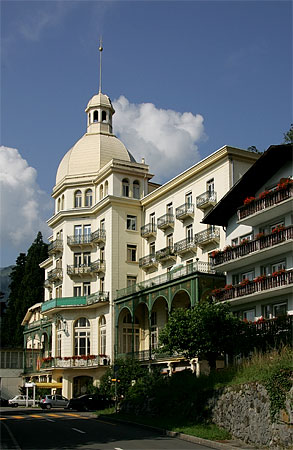
In 1968, the Maharishi announced he would stop public activities. Instead, he would focus on training TM teachers. This would happen at his new global headquarters in Seelisberg, Switzerland. In 1969, he started a course called Science of Creative Intelligence at Stanford University. This course was then offered at 25 other American universities.
In 1970, the Maharishi held a TM teacher training course in Maine with 1,200 people. Later that year, he held a similar course in California with 1,500 people. In 1970, he moved his headquarters to Italy due to some issues with Indian tax authorities. He returned to India in the late 1970s. That same year, the City of Hope Foundation gave the Maharishi their "Man of Hope" award.
By 1971, the Maharishi had completed 13 world tours. He had visited 50 countries. He also held a press conference with American inventor Buckminster Fuller. From 1970 to 1973, about 10,000 people attended his symposia. These events focused on his modern view of Vedanta philosophy. During these conferences, the Maharishi spoke with "leading thinkers" of the time.
The Maharishi announced his World Plan in 1972. Its goal was to create 3,600 TM centers globally. That year, a TM training course was held in Canada. One thousand young people from the USA and Canada attended. The Maharishi encouraged attendees to improve their appearance. He also persuaded the U.S. Army to offer TM courses to soldiers.
In March 1973, the Maharishi spoke to the Illinois state government. The legislature then supported using his Science of Creative Intelligence in public schools. Later that year, he organized a world conference for mayors in Switzerland. He also spoke to 3,000 educators about quality of life and higher education.
In 1974, Maharishi International University was founded in Fairfield, Iowa. In October 1975, the Maharishi was on the cover of Time magazine. He made his last visit to the TM center in Los Angeles in 1975.
In 1975, the Maharishi began a five-continent trip. He called it "the Dawn of the Age of Enlightenment." He visited Ottawa and met privately with Canadian prime minister Pierre Trudeau. They discussed TM principles and creating an ideal society. That same year, the Pittsburgh Press reported that other yogis criticized the Maharishi for simplifying their ancient art. The Maharishi appeared on The Merv Griffin Show in 1975 and 1977. This led to "tens of thousands of new practitioners" in the USA.
In the mid-1970s, the Maharishi's U.S. movement had 370 TM centers. They were staffed by 6,000 TM teachers. The Maharishi also began reaching out to businesses. His TM movement became more like a large international company.
In 1977, a U.S. court stopped the teaching of TM in a New Jersey public school. The court said the movement was religious. It ruled that public organizations adopting TM went against the separation of church and state.
During the 1980s, the organization continued to grow. His meditation technique still attracted famous people. The TM organization bought many properties. These included old mansions and hotels. Doug Henning and the Maharishi planned a Vedic amusement park called Vedaland. They bought land near Orlando, Florida, and Niagara Falls, Ontario. The park was meant to help people understand the universe's mysteries. These plans never happened. The Maharishi also ordered plans for the world's tallest building. It was to be a Vedic-style pyramid in Brazil.
In January 1988, offices in India connected to the Maharishi faced investigations by tax authorities. The Maharishi, who was in Switzerland at the time, later moved to the Netherlands. Following an earthquake in Armenia, the Maharishi trained Russian TM teachers. He also set up a health training center in Russia. Starting in 1989, the Maharishi's movement began adding "Maharishi" to the names of its new programs.
Years in Vlodrop (1991–2008)
In 1990, the Maharishi moved his headquarters to a former monastery in Vlodrop, the Netherlands. This place became known as MERU, Holland. While in Vlodrop, he mostly communicated through video and the internet. He also started a satellite TV channel called Veda Vision. It broadcast in 22 languages to 144 countries.
The Maharishi's last public appearance is believed to be in 1991. Deepak Chopra, who was one of the Maharishi's top assistants, wrote that the Maharishi became very ill in 1991. The illness was kept secret. Chopra said he cared for the Maharishi during his year-long recovery. According to Chopra, the Maharishi later asked him to stop traveling and writing books. This led Chopra to leave the movement in 1994.
As part of a world peace plan, the Maharishi started the Natural Law Party (NLP). He called it a "natural government." His followers founded the NLP in 1992. It was active in forty-two countries. Critics said the party was a way to recruit people for Transcendental Meditation. The Maharishi closed down the political effort in 2004. He said, "I had to get into politics to know what is wrong there."
In 1992, the Maharishi began sending groups of Yogic Flyers to different countries. This was to promote world peace through "coherent world consciousness." In 1993 and 2003, he decided to increase the fees for learning TM.
In 1997, the Maharishi's organization built the largest wooden structure in the Netherlands without using nails. This building was the Maharishi's home for the last twenty years of his life. In his later years, the Maharishi rarely left his two rooms. This was to protect his health and energy. He used video calls to talk to the world and his advisors.
In 2000, the Maharishi founded the Global Country of World Peace (GCWP). Its goal was to create global peace. The Maharishi named Tony Nader, a doctor and neuroscientist, as the king or Maharaja of the GCWP in 2000. The GCWP tried to create its own country. They offered money to the President of Suriname for land. In 2002, they tried to choose a king for a remote area in Costa Rica.
In 2001, followers of the Maharishi founded Maharishi Vedic City in the United States. This new city requires homes and buildings to be built according to special principles. These principles aim for "harmony with nature."
In 2002, the Maharishi appeared on the CNN show, Larry King Live. It was his first time in mainstream media in 25 years. He said, "Transcendental Meditation is something that can be defined as a means to do what one wants to do in a better way, a right way, for maximum results." That same year, a foundation connected to the Maharishi created a currency called the "Raam." It was meant to fund peace projects.
In 2003, David Lynch started a project to raise money for the Maharishi. The goal was to build a meditation center big enough for 8,000 people.
The Maharishi stopped TM training in Britain in 2005. This was because he disagreed with Prime Minister Tony Blair's decision to support the Iraq War. He lifted the ban after Blair resigned in 2007. During this time, some people were doubtful of his plans. These included a plan to end poverty through organic farming and a plan to use meditation to end conflict.
His Passing
Maharishi Mahesh Yogi became more private in his last years. He stayed mostly in two rooms of his home. He rarely met people in person. Instead, he talked to his followers mostly through video.
On January 12, 2008, his ninetieth birthday, the Maharishi said he was finishing his work. He wished for the world to live in peace and happiness.
A week before he passed away, the Maharishi said he was "stepping down as leader of the TM movement." He planned to spend his remaining time studying "ancient Indian texts." The Maharishi died peacefully in his sleep on February 5, 2008, at his home in the Netherlands. His funeral was held in India. It took place at his ashram overlooking the Ganges and Yamuna rivers.
The funeral was a state funeral. It was led by a spiritual leader from India. Many Indian officials and leaders attended. Thirty-five leaders from the Global Country of World Peace were also there. David Lynch also attended. The funeral was given state honors because the Maharishi was a recognized master in the tradition of Advaita Vedanta.
The Maharishi had a brother and several nephews. One nephew, Girish Chandra Varma, leads the Maharishi Vidya Mandir Schools Group. He is also a senior leader in the TM movement in India.
In its obituary, BBC News said the Maharishi's master gave him the job of keeping the Transcendental Meditation tradition alive. It also said that his "commercial mantras" drew criticism from some Hindus. But his promises of better health and spiritual enlightenment attracted people worldwide. Paul McCartney said he was sad about his passing. But he remembered him as a great man who worked hard for world unity.
His Impact
The Maharishi helped bring back India's ancient meditation traditions. He made them available to everyone. He is known for making meditation popular in the West. He did this by teaching Transcendental Meditation globally through his well-organized group. The Maharishi is also credited with suggesting that there is a unique "fourth state of consciousness." This state has a basis in how the body works. He also encouraged scientific studies on TM's effects. Newsweek said he helped start "a legitimate new field of neuroscience." The Times of India said his lasting contribution was his deep understanding of pure consciousness. A memorial building, the Maharishi Smarak, was opened in India in 2013.
Maharishi's Teachings
The Maharishi aimed to change "the course of human history." When he first started teaching, he had three main goals. First, to bring back spiritual traditions in India. Second, to show that meditation was for everyone. Third, to show that his teachings fit with science. The Maharishi believed in happiness. He wrote in 1967 that "being happy is of the utmost importance." He taught that everyone has "an unlimited reservoir of energy, intelligence, and happiness." He stressed that his meditation technique was a natural way to develop this potential.
Starting in 1962, the Maharishi began suggesting daily yoga exercises. He said these would help people grow faster.
He also taught that practicing Transcendental Meditation twice a day would create inner peace. He believed that "mass meditation sessions" could create outer peace. This would reduce violence and war. Some scholars say the Maharishi was a strong voice for the idea that many people meditating could lead to a time of "peace, harmony, and collective consciousness." Scholar Carl Olson wrote that TM was based on a philosophy where unchanging reality is different from the changing world. The Maharishi said people did not need to give up worldly activities to gain enlightenment.
According to author Jack Forem, the Maharishi said that experiencing transcendence helped people behave better. He believed it was easier to raise a person's awareness than to make them act right.
Some scholars say Maharishi Mahesh Yogi was one of many Indian teachers who brought new versions of Vedantic Hinduism to the West. Author Meera Nanda calls this "the brand of Hinduism that is taught by Maharishi Mahesh Yogi."
Author Barry Miles wrote that the media focused on the Maharishi. This was because young people seemed to listen to his anti-drug message. One TM participant said the Maharishi "signaled the beginning of the post-acid generation."
Transcendental Meditation Explained
In a 2002 CNN interview, the Maharishi said, "Transcendental Meditation is something that can be defined as a means to do what one wants to do in a better way, a right way, for maximum results." His movement offered advanced TM courses where people lived together. By the time he passed away, there were almost 1,000 TM training centers globally.
The Maharishi is known for bringing a simple and clear meditation technique to the Western world. He also introduced the scientific study of meditation.
In the mid-1970s, the Maharishi started the TM-Sidhi programme. This included Yogic Flying. It was an extra option for those who had practiced TM for some time. This new program focused on benefits for both individuals and groups. It led to a new idea called the Maharishi Effect. This effect is said to "create coherence in the collective consciousness." It is also believed to reduce crime, violence, and accidents.
Maharishi Vedic Science
Maharishi Vedic Science (MVS) is based on the Maharishi's understanding of ancient Vedic texts. This understanding came from his teacher, Brahmananda Saraswati. MVS aims to present traditional Vedic knowledge in a way that Western science can understand. According to Roy Ascott, MVS also explains that every person can experience the infinite nature of pure consciousness. This is also called Being or Self. This can happen even during daily activities. When this state is fully reached, a person is no longer affected by outside things. They see pure consciousness in everything.
MVS has two parts. The first is the practical part, which includes the Transcendental Meditation technique and the TM-Sidhi program. The second is the theoretical part. This explains how MVS can be used in daily life. These uses include programs in:
- Maharishi Vedic Approach to Health (MVAH): A health system.
- Maharishi Sthapatya Veda: A system for designing and building structures.
- Maharishi Gandharva Veda: A type of classical Indian music.
- Maharishi Jyotish (also known as Maharishi Vedic Astrology): A system that claims to evaluate a person's life path.
- Maharishi Vedic Agriculture: A special way to grow fresh, organic food.
- Consciousness-Based Education: An education approach.
According to educator James Grant, the Maharishi brought a "full revival of the Vedic tradition of knowledge from India." He showed how it was important in many areas, like education, business, and medicine.
His Books
The Maharishi wrote over twenty books about Transcendental Meditation and Maharishi Vedic Science.
The Beacon Light of the Himalayas
In 1955, a conference in Kerala published The Beacon Light of the Himalayas. This 170-page book was a record of the conference. Some authors say this was the Maharishi's first published book on Transcendental Meditation. The book was dedicated to Maharshi Bala Brahmachari Mahesh Yogi Rajaram. It included photos, letters, and talks in different languages.
Science of Being and Art of Living
In 1963, the Maharishi recorded the text for his book Science of Being and Art of Living. It was later written down and published in fifteen languages. K.T. Weidmann describes this book as the Maharishi's main philosophical work. In it, he explains ancient Indian traditions in a way that Western science can understand. In Science of Being, the Maharishi talks about two types of reality. Relative existence is our everyday experience through our senses. Absolute reality is the origin of everything and the source of all creativity. The Maharishi describes this absolute reality as unchanging, everywhere, and eternal. He also calls it bliss consciousness. These two parts of reality are like an ocean with many waves. The waves are the changing world, and the ocean beneath is the unchanging foundation. Being connected to this unchanging reality brings stability.
In his Science of Being, the Maharishi also introduced a new idea. He said that fulfillment comes not from hard work, but from the mind settling down during TM practice. This was the first full explanation of the ideas behind the Maharishi's teachings.
Other Projects and Programs
Maharishi International University (renamed Maharishi University of Management (MUM) in 1995) was the first university the Maharishi founded. It started classes in Santa Barbara, California, in 1973. In 1974, the university moved to Fairfield, Iowa, where it is today. The university has a library of the Maharishi's recorded talks and writings. This includes the thirty-three-lesson Science of Creative Intelligence course. This course explains higher states of consciousness and how to reach them.
The Maharishi Vidya Mandir Schools (MVMS) is an education system in India. It was founded in 1995 by the Maharishi. It has 148 schools in 118 cities. It teaches 90,000 to 100,000 students and has 5,500 staff.
In 1998, Maharishi Open University was founded. It could be accessed through a network of eight satellites and the Internet.
The Maharishi also introduced ideas for management, defense, and government programs. These were designed to help reduce poverty. He also introduced a new economic currency called the Raam. In 2000, the Maharishi began building centers called "Peace Palaces" around the world. By 2008, at least eight were built in the US. The Maharishi Institute, an African university, was founded in 2007. It uses his Transcendental Meditation technique in its teaching.
In his farewell message on January 11, 2008, Maharishi Mahesh Yogi announced the creation of the Brahmananda Saraswati Trust (BST). It was named after his teacher. This trust was set up to support over 30,000 Vedic Pandits in India. These Pandits work to create peace.
Organizations and Businesses
The Maharishi led charities, businesses, and real estate investments. Their total value has been estimated to be billions of dollars. His real estate holdings in the United States were valued at about $250 million in 2008. These included hotels, commercial buildings, and undeveloped land. The Maharishi's movement is funded through donations, course fees for Transcendental Meditation, and real estate deals.
See also
 In Spanish: Maharishi Mahesh Yogi para niños
In Spanish: Maharishi Mahesh Yogi para niños



